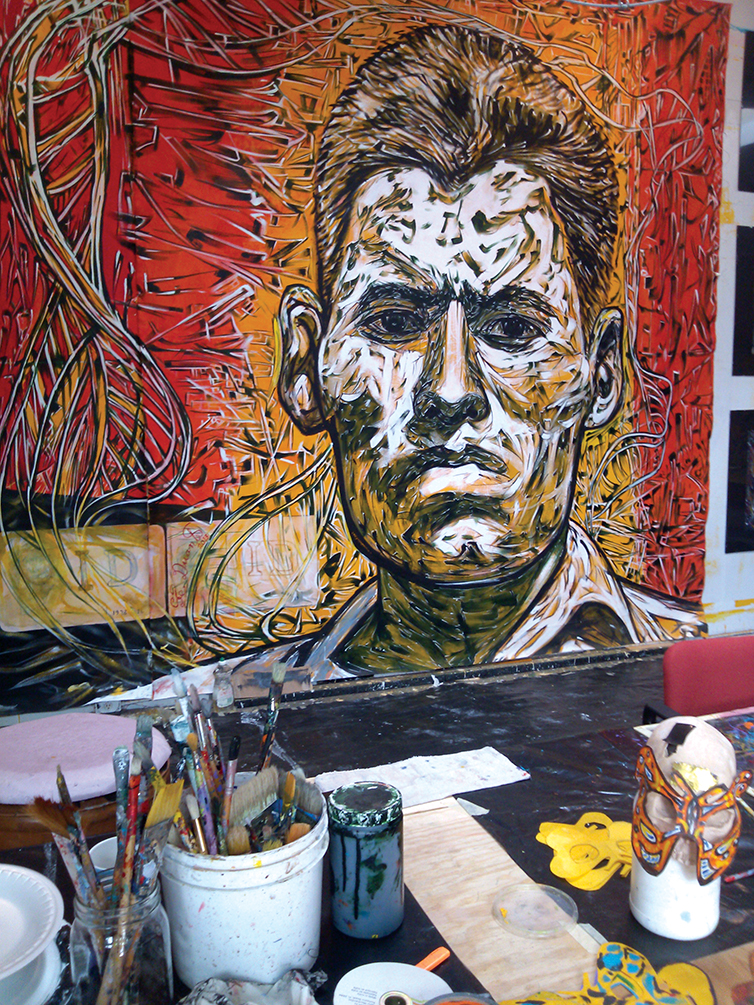
Hector Duarte’s studio is full of butterflies and barbed wire. If you counted up every orange monarch butterfly that flits by in the paintings and murals that line the walls of his workspace, there would be dozens, perhaps hundreds, in the front room alone. But for every butterfly he paints, there’s usually a wicked strand of barbed wire right next to it.
For Duarte, who hails from Michoacán, Mexico, the barbed wire represents the border between Mexico and the United States, while the butterflies represent the possibility of erasing that border.
“I relate everything with this theme to immigration,” he says. “The butterfly flies from Canada to Mexico. The butterflies fly freely, and the human being does not—they go and come back.”
Duarte opened his Pilsen studio to the public for the Chicago Architecture Foundation’s annual Open House tours. His house is difficult to miss, as it displays one of the most notable murals in a neighborhood noted for its murals: “Gulliver en el pais de las maravillas,” or Gulliver in Wonderland. The entire building is covered with a mural of Duarte as the giant Gulliver, tied down with barbed wire in a strange new land.
Upbeat traditional Mexican music played on Duarte’s iPod for visitors to enjoy as they mulled around his studio and checked out his works-in-progress. One of his big projects right now is a thirty-by-ten-foot mural that shows barbed wire turning into a cocoon for a human butterfly. The mural radiates with bright shades of orange, red, and black, a vivid palette characteristic of much of his work.
On the other wall is a mural of Duarte himself and his late father, the only other person in his family to migrate to America. Rafael Duarte came to the United States during the Second World War as part of the brasero migrant worker program, working in the fields of California, Oregon, and Washington. Rafael is nineteen in the mural, while his son is represented at his current age.
The mural is painted in shades of red and orange, highlighted in green with an intensity matched by the expression on the father’s face. Every brushstroke is thick and angular, creating motion lines all over the two men’s faces. A strand of DNA weaves them together.
Duarte says that big pieces like this take him around three months to finish. At the same time, he’s often busy working on commissions from schools, libraries, and other public spaces. The artist has been working in Chicago since 1985, and over fifty of his murals can be seen around the region.
The main appeal of murals, for him, is that “nobody need pay nothing and everyone can enjoy it. You need to pay in the museum, and not all people can go to the museum.”
Duarte began studying mural art in 1977 in a workshop set up by the widow of the legendary Mexican muralist David Alfaro Siqueiros. Siqueiros was one of the founders of Mexican muralism, along with Diego Rivera and Jose Clemente Orozco. Duarte explained that the main idea behind the Siqueiros method is the technique of “polyangularity,” where many different angles on the painting create different points of view for the spectator.
“He codified something about how you can integrate the mural paint in the architecture,” said Duarte. “That’s why I continue with this tradition. I integrate every corner, every space. I would like to paint all the city with murals.” He now teaches other artists the Siqueiros method, having set up artist collectives in Zacatecas, Zamora, and Chicago.
Duarte first visited Chicago in 1978, and decided that it would be a great place for his art. “I found this barrio, Pilsen, and I saw the murals in the streets, and I said, okay, this is good for me.” Seven years later he migrated, leaving almost his entire family behind in Mexico. But once Duarte moved to America, his artwork changed significantly from the style he had learned in Mexico.
“The artists here in Chicago paint in Mexican symbols,” he said. “Zapata, pyramids…why? When I came here, yo comprendi, I realized—” (here, he switched to Spanish) “—that they needed those symbols, because here they need to say somos esto, we are this. We have a culture.”
That’s when Duarte began using symbols like corn and hearts in his work, because of their importance in Mexican culture. He says he has a “corn heart,” and he takes that phrase seriously. One of his paintings is called “La Virgen de Maiz”. The corn-cob Virgin Mary watched over the crowd in Duarte’s studio that day with as much compassion and tranquility as her human-shaped counterpart.
Close-by is a painting of a heart made of the Mexican and American flags, the two halves wounded and sewn together with barbed wire. “One heart in two countries and two cultures; one heart suffers on both sides,” Duarte explains. The culture shock forces him to hold on to symbols of his own identity.
“We suffer when we migrate to some place. We suffer in different ways. Different cultures, different everything. [Different] architecture, different food, different language, everything. And different people, from all parts of the world.”
Even his color palette changed after coming to America—an unexpected consequence of Chicago’s uninspiring weather, according to him. “I understand why the Chicano movement uses bright colors. Here, it’s gray, gray. Everything is gray,” he says. “They need to see the papaya color, orange, mangoes, and flowers everywhere, and green. I don’t know; they need it. I don’t know if it’s true, but I think so.”
Go to Mexico, Duarte says, and you would see that the very air and sky look different. “I understand why the Anglo people paint in soft tones,” he says. “They have those tones in the weather. They have the blue sky, it’s a baby blue. But we need a strong cerulean, or cobalt!”


